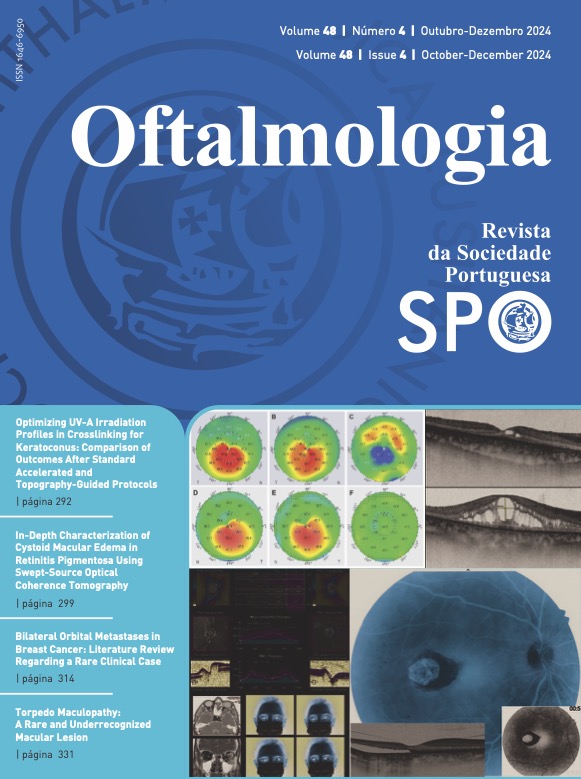Experiência Clínica e Perfil de Segurança das Injeções Intravítreas num Hospital Terciário
DOI:
https://doi.org/10.48560/rspo.33167Palavras-chave:
Infeções Oculares, Injeções IntravítreasResumo
INTRODUÇÃO: O nosso objetivo foi avaliar a experiência real e o perfil de segurança das injeções intravítreas (IVI) de anti-vascular endothelial growth factor (anti-VEGF) e/ou corticosteroides para diferentes condições oftalmológicas.MÉTODOS: Estudo retrospetivo e observacional, que incluiu os olhos submetidos a IVI durante o primeiro semestre de 2022. As indicações clínicas, a classe de medicamento administrado e a taxa de adesão terapêutica foram avaliadas. Questões de segurança e complicações cirúrgicas foram analisadas durante o follow-up de janeiro a dezembro de 2022.
RESULTADOS: Foram avaliadas 3491 IVI realizadas em 1281 olhos (de 1024 pacientes). As indicações mais comuns foram neovascularização macular (NVM) (35,1%, n=450) e edema macular diabético (EMD) (34,6%, n=433), seguidos de oclusão venosa retiniana (OVR) (16,4%, n=208), retinopatia diabética proliferativa (7,3%, n=94) e edema inflamatório (4,8%, n=62). Obteve-se uma taxa de adesão terapêutica de 90,7% (n=3491 IVI realizadas): considerando as consultas perdidas, os pacientes com EMD contribuíram com 43,1% das consultas perdidas, seguidos de MNV (30,5%) e RVO (16,1%). O medicamento anti-VEGF mais frequentemente injetado foi aflibercept (39,1%, n=501), seguido de bevacizumab (25,8%, n=330), ranibizumab (21,8%, n=279) e brolucizumab (5,4%, n=69). Entre os corticosteroides, o implante de dexametasona (5,9%, n=76) foi o mais utilizado, seguido do acetonido de triancinolona (1,6%, n=21) e do implante de fluocinolona (0,4%, n=5). A frequência de switch foi de 9,8%. Em 40,5% dos casos de troca, o brolucizumab foi a escolha para tratamento subsequente, seguido pelo aflibercept (31,7%) e ranibizumab (10,3%). Durante o follow-up, ocorreram complicações em 100 olhos (taxa global de 2,86%): n=89 (taxa de 2,53%) hipertensão ocular necessitando de terapia adicional ou cirurgia; n=2 (taxa de 0,06%) uveíte após aflibercept; n=2 (taxa de 0,06%) descolamento de retina, n=2 (taxa de 0,06%) vasculite após brolucizumab e n=2 (taxa de 0,06%) catarata após IVI; n=1 (taxa de 0,03%) endoftalmite, n=1 (taxa de 0,03%) hemorragia vítrea e n=1 (taxa de 0,03%) implante de dexametasona na câmara anterior.
CONCLUSÃO: Os eventos adversos oculares associados às IVI foram relativamente baixos e refletem a segurança destes tratamentos. No agendamento da IVI, alguns fatores devem ser levados em consideração para garantir os melhores resultados possíveis e altas taxas de adesão terapêutica.
Downloads
Referências
Grzybowski A, Told R, Sacu S, Bandello F, Moisseiev E, Loewenstein A, Schmidt-Erfurth U; Euretina Board. 2018 Update on Intravitreal Injections: Euretina Expert Consensus Recommendations. Ophthalmologica. 2018;239:181-93. doi: 10.1159/000486145.
Leite J, Castro C, Abreu AC, Pessoa B, Furtado MJ, Lume M, et al. Posterior Capsular Rupture during Cataract Surgery in Eyes Previously Treated with Intravitreal Injections. Ophthalmologica. 2023;246:9-13. doi: 10.1159/000528657.
Frenkel RE, Haji SA, La M, Frenkel MP, Reyes A. A protocol for the retina surgeon’s safe initial intravitreal injections. Clin Ophthalmol. 2010;4:1279-85. doi: 10.2147/OPTH.S12846.
Reibaldi M, Fallico M, Avitabile T, Marolo P, Parisi G, Cennamo G, et al. Frequency of Intravitreal Anti-VEGF Injections and Risk of Death: A Systematic Review with Meta-analysis. Ophthalmol Retina. 2022;6:369-76. doi: 10.1016/j.oret.2021.12.019.
Bolme S, Austeng D, Morken TS, Follestad T, Halsteinli V. Cost consequences of task-shifting intravitreal injections from physicians to nurses in a tertiary hospital in Norway. BMC Health Serv Res. 2023;23:229. doi: 10.1186/s12913-023-09186-0.
Rocha JV, Marques AP, Macedo AF, Afonso-Silva M, Laires P, Almeida AS, et al. Trends, geographical variation and factors associated with the use of anti-VEGF intravitreal injections in Portugal (2013-2018): a retrospective analysis of administrative data. BMJ Open. 2022;12:e055478. doi: 10.1136/bmjo-
pen-2021-055478.
Wang R, McClard CK, Laswell S, Mahmoudzadeh R, Salabati M, Ammar M, et al. Quantifying burden of intravitreal injections: questionnaire assessment of life impact of treatment by intravitreal injections (QUALITII). BMJ Open Ophthalmol. 2022;7:e001188. doi: 10.1136/bmjophth-2022-001188.
Shalchi Z, Okada M, Whiting C, Hamilton R. Risk of Posterior Capsule Rupture During Cataract Surgery in Eyes With Previous Intravitreal Injections. Am J Ophthalmol. 2017;177:77-80. doi: 10.1016/j.ajo.2017.02.006.
Falavarjani KG, Nguyen QD. Adverse events and compli-cations associated with intravitreal injection of anti-VEGF agents: a review of literature. Eye. 2013;27:787-94. doi: 10.1038/eye.2013.107.
Rajesh B, Zarranz-Ventura J, Fung AT, Busch C, Sahoo NK, Rodriguez-Valdes PJ, et al. Safety of 6000 intravitreal dexa-methasone implants. Br J Ophthalmol. 2020;104:39-46. doi: 10.1136/bjophthalmol-2019-313991.
Kristiansen IS, Haugli Bråten R, Jørstad ØK, Moe MC, Saether EM. Intravitreal therapy for retinal diseases in Norway 2011-2015. Acta Ophthalmol. 2020;98:279-85. doi: 10.1111/aos.14262.
Marques AP, Macedo AF, Perelman J, Aguiar P, Rocha-Sousa A, Santana R. Diffusion of anti-VEGF injections in the Portuguese National Health System. BMJ Open. 2015;5:e009006. doi: 10.1136/bmjopen-2015-009006.
Chopra R, Preston GC, Keenan TD, Mulholland P, Patel PJ, Balaskas K, et al. Intravitreal injections: past trends and future projections within a UK tertiary hospital. Eye. 2022;36:1373-78. doi: 10.1038/s41433-021-01646-3.
Denniston AK, Lee AY, Lee CS, Crabb DP, Bailey C, Lip PL, et al. United Kingdom Diabetic Retinopathy Electronic Medical Record (UK DR EMR) Users Group: report 4, real-world data on the impact of deprivation on the presentation of diabetic eye disease at hospital services. Br J Ophthalmol. 2019;103:837-43. doi: 10.1136/bjophthalmol-2018-312568.
Li JQ, Welchowski T, Schmid M, Mauschitz MM, Holz FG, Finger RP. Prevalence and incidence of age-related macular degeneration in Europe: a systematic review and meta-analysis. Br J Ophthalmol. 2020;104:1077-84. doi: 10.1136/bjophthalmol-2019-314422.
Pessoa B, Ferreira A, Leite J, Figueira J, Meireles A, Beirão JM. Optical Coherence Tomography Biomarkers: Vitreous Status Influence in Outcomes for Diabetic Macular Edema Therapy with 0.19-mg Fluocinolone Acetonide Implant. Ophthalmic Res. 2021;64:639-47. doi: 10.1159/000515306.
Brown DM, Emanuelli A, Bandello F, Barranco JJ, Figueira J, Souied E, et al. KESTREL and KITE: 52-Week Results From Two Phase III Pivotal Trials of Brolucizumab for Diabetic Macular Edema. Am J Ophthalmol. 2022;238:157-72. doi: 10.1016/j.ajo.2022.01.004.
Leite J, Ferreira A, Castro C, Coelho J, Borges T, Correia N, et al. Retinal changes after fluocinolone acetonide implant (ILUVIEN®) for DME: SD-OCT imaging assessment using ESASO classification. Eur J Ophthalmol. 2024;34:233-44. doi: 10.1177/11206721231183471.
Arcinue CA, Saboo US, Stephen Foster C. Corticosteroids in uveitis. Retin Today. 2021:72–4.
Ip MS. Intravitreal injection of triamcinolone: an emerging treatment for diabetic macular edema. Diabetes Care. 2004;271794-7. doi: 10.2337/diacare.27.7.1794.
Sigford DK, Reddy S, Mollineaux C, Schaal S. Global reported endophthalmitis risk following intravitreal injections of anti-VEGF: a literature review and analysis. Clin Ophthalmol. 2015;9:773-81. doi: 10.2147/OPTH.S77067.
Baudin F, Benzenine E, Mariet AS, Bron AM, Daien V, Korobelnik JF, et al. Association of Acute Endophthalmitis With Intravitreal Injections of Corticosteroids or Anti-Vascular Growth Factor Agents in a Nationwide Study in France. JAMA Ophthalmol. 2018;136:1352-8. doi: 10.1001/jamaophthalmol.2018.3939.
Khanani AM, Cohen GL, Zawadzki R. A Prospective Masked Clinical Assessment of Inflammation After Intravitreal Injection of Ranibizumab or Aflibercept. J Ocul Pharmacol Ther. 2016;32:216-8. doi: 10.1089/jop.2015.0152.
Wykoff CC, Garweg JG, Regillo C, Souied E, Wolf S, Dhoot DS, et al. KESTREL and KITE Phase 3 Studies: 100-Week Results With Brolucizumab in Patients With Diabetic Macular Edema. Am J Ophthalmol. 2024;260:70-83. doi: 10.1016/j.ajo.2023.07.012.
Downloads
Publicado
Como Citar
Edição
Secção
Licença
Direitos de Autor (c) 2024 Revista Sociedade Portuguesa de Oftalmologia

Este trabalho encontra-se publicado com a Creative Commons Atribuição-NãoComercial 4.0.
Não se esqueça de fazer o download do ficheiro da Declaração de Responsabilidade Autoral e Autorização para Publicação e de Conflito de Interesses
O artigo apenas poderá ser submetido com esse dois documentos.
Para obter o ficheiro da Declaração de Responsabilidade Autoral, clique aqui
Para obter o ficheiro de Conflito de Interesses, clique aqui





